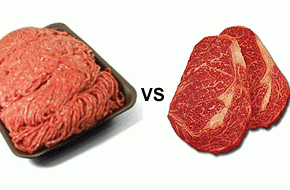
By Allan Barber
A cursory analysis of beef and lamb exports from New Zealand and Australia shows some similarities as well as some significant differences between them.
Some of these variations are due to quota constraints, notably New Zealand’s historical access to the EU for lamb, others to product type, such as Australia’s beef exports to North Asia and the growing influence of dairy beef in this country.
Australia exports roughly three times as much beef as New Zealand, although the US market takes comparable volumes of beef from both countries, 212, 000 MT versus 175,000 MT in the latest 12 months for which statistics are available.
However a far higher proportion of our exports is in grinding beef for the hamburger trade.
The most notable differences in the respective export patterns are in the volumes of beef to North Asia and lamb volumes to the EU. Australia exports four times more beef to Japan, Korea and Taiwan than New Zealand does because of a combination of tariffs and taste preference for grain fed over grass fed beef.
New Zealand has in the recent past done a good job of expanding its exports to China, up nearly six fold last year to 36,000 MT, but even here, in spite of our FTA with China, Australian exports increased by more than seven times to 140,000 MT.
This is not necessarily a bad thing in view of the need to maximise export values and market mix, but it does emphasise Australia’s enormous scale in beef.
The drought in Australia’s main cattle areas, Northern Territory, Queensland and northern New South Wales, is likely to cause a reduction in the Australian beef herd, causing a drop in export volumes.
Nevertheless Australian beef exports will continue to outnumber New Zealand’s by a wide margin with a far higher proportion in traditional prime beef as opposed to grinding beef.
-------------------------------------------------------------------------------------------------------------------------------------------
Farms For Sale: the most up-to-date and comprehensive listing of working farms in New Zealand, here »
-------------------------------------------------------------------------------------------------------------------------------------------
The difference in respective lamb markets is even more significant.
Australian exports have increased by 53,000 MT or a third in the last three years, although the New Zealand figure also increased significantly in the most recent 12 month period.
We export 100,000 MT more than Australia whose main markets are the USA, Middle East and China. Nor does Australia have much access to the lucrative EU market where it sells less than it does to Papua New Guinea.
New Zealand’s main lamb markets are EU which took 40% of export volumes, North Asia including China which imported 32% and the USA.
Prices differ enormously between these markets with the USA commanding the highest price level based on a limited product range followed by the EU.
China which overtook the UK as the largest single country importing New Zealand lamb last year commands a price approximately half that of the European price.
As these figures suggest, market access and achievable prices are constantly fluctuating; the challenge for New Zealand trade negotiators and exporters is to ensure the best possible market access and product returns from the available market mix.
---------------------------------------------------------------------------------------
Here are some links for updated prices for
- lamb
- beef
- deer
- wool
M2 Bull
Select chart tabs
---------------------------------------------------------------------------------------
Allan Barber is a commentator on agribusiness, especially the meat industry, and lives in the Matakana Wine Country where he runs a boutique B&B with his wife. You can contact him by email at allan@barberstrategic.co.nz or read his blog here ».

We welcome your comments below. If you are not already registered, please register to comment
Remember we welcome robust, respectful and insightful debate. We don't welcome abusive or defamatory comments and will de-register those repeatedly making such comments. Our current comment policy is here.